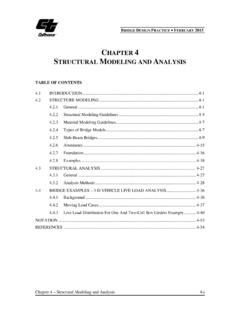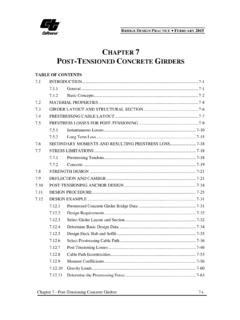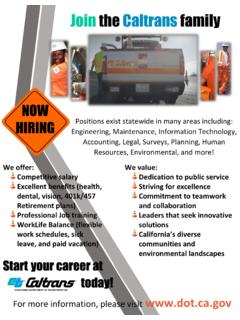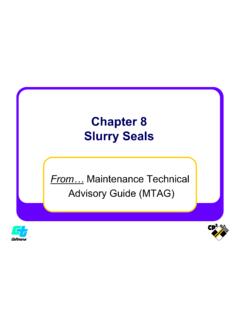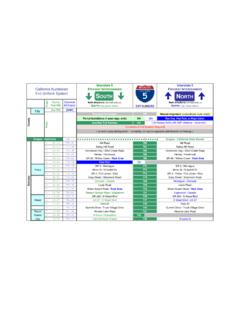Transcription of Bridge Design Memo 9.4 • Octo
1 Bridge Design Memo October 2021 Typical Deck, Typical Overhang, and Soffit Design 1 TYPICAL DECK, TYPICAL OVERHANG, ANDSOFFIT Design GENERAL This BDM addresses the Design of typical Bridge decks, typical overhangs, and soffits for new bridges and Bridge widenings as described in STP The deck and soffit Design tables in this BDM provide the minimum allowable section thicknesses and reinforcement for a given girder spacing. The deck Design tables are considered the Design standards developed by Caltrans as described in Article DEFINITIONS Bay - Area between centerlines of adjacent girders CL - Centerline D bars (Distribution bars) - Longitudinal bars in the bottom mat of deck reinforcement placed above the bottom transverse bars E bars - Transverse bars in the top and bottom mats of soffit reinforcement F dimension - Location of top bend of deck truss bars measured from the Design section for negative moment (inches) G bars - Longitudinal bars in the bottom mat of deck reinforcement placed below the bottom transverse bars to facilitate construction H bars - Longitudinal bars in the top and bottom mats of soffit reinforcement S - Transverse deck bar spacing as shown in Standard Plan B0-5 Bridge DETAILS, Bridge Detail 5-10 and Bridge Detail 5-11 (inches) Soffit - Bottom slab of box girders T - Thickness of the deck slab within the bays (inches)
2 LOADING, ANALYSIS, AND Design The deck Design tables and figure were generated using the approximate method of Bridge Design Memo October 2021 2 Typical Deck, Typical Overhang, and Soffit Design analysis as specified in Article for decks and overhangs and for the additional overhang requirements in Article The designs in the deck tables are mostly controlled by the Service Limit State, except for the smaller girder spacings, which are controlled by the Extreme Event Limit State. Empirical Design of typical decks and overhangs is not allowed per Article Decks and Overhangs The decks and overhangs are designed for STRENGTH I (Articles and ) and SERVICE I (Article ) Limit States. STRENGTH II was considered but did not control (see Article ). For SERVICE I, a exposure factor and an assumed inches of cover in the calculation of dc for negative moment were incorporated per Article The Design section for negative moment reinforcement is as specified in Article Live load moment demands are taken from the table in Article A4.
3 The assumptions and limitations listed in Article A4 apply. The decks and overhangs are not designed for heavy construction equipment such as cranes and material hauling equipment. If such loads are expected, the deck or overhang shall be specially designed to accommodate these additional loads as described in STP Dead loads only include the self-weight of the deck and overhang and a future wearing surface of 35 psf. The moment demands are based on a continuous beam supported on pinned connections to the girders. Any additional dead loads such as utilities, median barriers and overhead signs should be considered. Additional Requirements for Overhangs The overhangs are also designed for the EXTREME EVENT II limit state, Design Cases 1 and 2, as described in Article For Design Case 1, Article is incorporated. The Design conforms to the maximum test level of TL-4 as described in Article The Design is adequate for overhangs supporting solid concrete parapet railings and with minimum overhang thicknesses as described in If the overhang supports post-type barriers, sound walls, overhead signs, or utilities, it should be checked for the associated additional loads.
4 DECK AND OVERHANG CONCRETE The minimum Bridge deck thickness, T , is as shown in the Deck Design Tables , Bridge Design Memo October 2021 Typical Deck, Typical Overhang, and Soffit Design 3 , and The minimum deck thicknesses are greater than those required by Article The thicknesses were determined based on past performance and the desire to provide a deck and overhang Design capable of lasting the life of the Bridge with minimal maintenance costs. Concrete cover for decks and overhangs shall comply with Article If additional cover to those shown in Figure is required, the deck and overhang thicknesses shall be increased accordingly. The deck overhang thickness shall be a minimum of 8 inches at the edge of deck for all Bridge types per Article For CIP concrete box girders and T beams, the overhang thickness shall be a minimum of 12 inches at the face of exterior girder. This 12-inch minimum overhang thickness requirement should be applied to all typicaloverhangs, but it may not be feasible for overhangs on steel or precast girders.
5 When itis not feasible to provide the 12-inch minimum thickness, the overhang shall be evaluatedfor the Design cases in Article specified minimum compressive strength for deck and overhang concrete is ksi per Article The deck and overhang concrete shall be normal weight and be specified as containing polymer fibers per the standard specifications. Decks and overhangs utilizing lightweight concrete are considered non-typical and require special Design . DECK AND OVERHANG REINFORCEMENT The specified minimum yield strength for all reinforcing bars is 60 ksi. The deck and overhang transverse reinforcement may utilize the truss bar option or only straight bars as shown in Standard Plan B0-5 Bridge DETAILS, Bridge Detail 5-10 and Bridge Detail 5-11. If the truss bar option is allowed and a future widening is anticipated, additional transverse bottom mat reinforcement should be provided. These bars should be developed past the exterior girder to ensure the future closure pour bay will have adequate bottom reinforcement.
6 The use of the truss bar option versus only straight bars and the orientation of the transverse reinforcement, based on the Bridge skew, should conform to the Bridge Design Details Manual and shown in the plans. The D bars shown in the tables conform to Article , with S assumed to be equal to the length between negative moment Design sections. These bars should be distributed as evenly as possible between the negative moment Design sections, with one bar being placed at the inside of each bottom truss bar bend. The spacing of the bars Bridge Design Memo October 2021 4 Typical Deck, Typical Overhang, and Soffit Design located within the bottom truss bar bends should be less than or equal to the spacing of the bars located outside of the bottom truss bar bends. The longitudinal top mat deck and overhang reinforcement shall not be smaller than #5 bars and shall be spaced at a maximum of 12 inches. This requirement is in addition to what is required by Articles and , but it is intended to increase the deck service life.
7 Continuous longitudinal reinforcement is required at all stirrup hooks, at bends in deck reinforcement, at the edge of deck, and adjacent to rail dowels per Standard Plan B0-5 Bridge DETAILS, Bridge Detail 5-15. Additional top mat transverse deck and overhang reinforcement is required in the overhang for a distance of 5 feet on both sides of a barrier rail expansion joint and at the ends of a barrier rail. The additional minimum transverse reinforcement consists of bars matching the size of the transverse bars, extending for a minimum length of 25 bar diameters beyond the centerline of the exterior girder, and bundled with every other top transverse bar in the overhang. The additional bars are not required when the center-to-center spacing between the girders exceeds feet. Top diaphragm reinforcement adjacent to expansion joints, which extends to the edge of deck, may be considered effective in meeting this requirement. Figure Typical Concrete Deck and Overhang Details Bridge Design Memo October 2021 Typical Deck, Typical Overhang, and Soffit Design 5 Table Deck Design for Reinforced Concrete Box Girders and Steel Girders with Flange Widths from 12 inches to less than 24 inches NOTE: The negative moment Design section for transverse reinforcement is 3 inches from the girder centerline.
8 Girder CL to CL Spacing (feet) Deck slab Thickness, T (inches) Transverse Bar Size and Maximum Bar Spacing, S (inches) F dimension (inches)#5 D Bars per Bay (quantity)#4 G Bars per Bay (quantity)Bar Size S 8 #5 12 6 5 2 8 #5 12 6 6 2 8 #5 12 6 6 2 8 #5 12 7 6 2 8 #5 12 7 7 2 8 #5 12 7 7 3 8 #5 12 8 7 3 8 #5 11 8 8 3 8 #5 11 9 9 3 8 #5 11 9 9 3 8 #5 11 9 9 3 8 #5 11 10 10 3 8 #5 10 10 11 3 8 #5 10 11 11 3 8 #5 10 11 12 3 8 #5 10 11 12 3 8 #5 10 12 13 3 8 #5 10 12 13 4 8 #5 10 13 13 4 #5 10 13 14 4 #5 10 13 14 4 #5 10 14 15 4 #5 10 14 15 4 #5 10 14 15 4 #6 12 15 19 4 Bridge Design Memo October 2021 6 Typical Deck, Typical Overhang, and Soffit Design Girder CL to CL Spacing (feet) Deck slab Thickness, T (inches) Transverse Bar Size and Maximum Bar Spacing, S (inches) F dimension (inches)#5 D Bars per Bay (quantity)#4 G Bars per Bay (quantity)Bar Size S #6 11 15 21 4 #6 11 16 21 4 #6 11 16 22 4 #6 11 16 22 4 #6 11 17 23 5 9 #6 11 17 23 5 #6 11 18 23 5 #6 10 18 26 5 #6 10 18 26 5 #6 10 19 26 5 #6 10 19 27 5 #6 10 19 27 5 #6 10 20 27 5 #6 10 20 28 5 #6 10 21 28 5 #6 10 21 28 5 10 #6 10 21 28 5 #6 10 22 29 5 #6 10 22 29 5 #6 10 23 29 5 Bridge Design Memo October 2021 Typical Deck, Typical Overhang, and Soffit Design 7 Table Deck Design for Cast-in-Place Prestressed Box Girders, Precast I -Girders, and Steel Girders with flange widths 24 inches or greater NOTE: The negative moment Design section for transverse reinforcing is 6 inches from the girder centerline.
9 Girder CL to CL Spacing (feet) Deck slab Thickness, T (inches) Transverse Bar Size and Maximum Bar Spacing, S (inches) F dimension (inches) #5 D Bars per Bay (quantity)#4 G Bars per Bay (quantity)Bar Size S 8 #5 12 5 5 2 8 #5 12 5 5 2 8 #5 12 6 5 2 8 #5 12 6 6 2 8 #5 12 6 6 2 8 #5 12 7 6 2 8 #5 12 7 7 2 8 #5 12 7 7 3 8 #5 12 8 7 3 8 #5 12 8 8 3 8 #5 12 9 8 3 8 #5 11 9 9 3 8 #5 11 9 9 3 8 #5 11 10 10 3 8 #5 11 10 10 3 8 #5 11 11 10 3 8 #5 11 11 11 3 8 #5 11 11 11 3 8 #5 11 12 11 3 8 #5 11 12 12 4 8 #5 11 13 12 4 #5 11 13 13 4 #5 11 13 13 4 #5 10 14 15 4 #5 10 14 15 4 Bridge Design Memo October 2021 8 Typical Deck, Typical Overhang, and Soffit Design Girder CL to CL Spacing (feet) Deck slab Thickness, T (inches) Transverse Bar Size and Maximum Bar Spacing, S (inches) F dimension (inches) #5 D Bars per Bay (quantity)#4 G Bars per Bay (quantity)Bar Size S #5 10 14 15 4 #5 10 15 16 4 #5 10 15 16 4 #6 11 16 21 4 #6 11 16 22 4 #6 11 16 22 4 #6 11 17 23 5 #6 11 17 23 5 #6 11 18 23 5 #6 11 18 24 5 #6 11 18 24 5 #6 10 19 26 5 #6 10 19 27 5 #6 10 19 27 5 #6 10 20 27 5 #6 10 20 28 5 #6 10 21 28 5 #6 10 21 28 5 #6 10 21 28 5 #6 10 22 29 5 Bridge Design Memo October 2021 Typical Deck, Typical Overhang, and Soffit Design 9 Table Deck Design for Precast Bulb-Tee Girders and Precast Wide Flange Girders NOTE: The negative moment Design section for transverse reinforcement is 15 inches from the girder centerline.
10 Girder CL to CL Spacing (feet) Deck slab Thickness, T (inches) Transverse Bar Size and Maximum Bar Spacing, S (inches) F dimension (inches) #5 D Bars per Bay (quantity)#4 G Bars per Bay (quantity)Bar Size S 8 #5 12 2 4 2 8 #5 12 3 4 2 8 #5 12 3 4 2 8 #5 12 3 5 2 8 #5 12 4 5 2 8 #5 12 4 5 2 8 #5 12 5 5 2 8 #5 12 5 5 2 8 #5 12 6 5 2 8 #5 12 6 6 2 8 #5 12 6 6 2 8 #5 12 7 6 2 8 #5 12 7 7 2 8 #5 12 7 7 3 8 #5 12 8 7 3 8 #5 12 8 8 3 8 #5 12 9 8 3 8 #5 12 9 8 3 8 #5 12 9 9 3 8 #5 12 10 9 3 8 #5 12 10 9 3 8 #5 11 11 10 3 8 #5 11 11 11 3 8 #5 11 11 11 3 8 #5 11 12 11 3 Bridge Design Memo October 2021 10 Typical Deck, Typical Overhang, and Soffit Design Girder CL to CL Spacing (feet) Deck slab Thickness, T (inches) Transverse Bar Size and Maximum Bar Spacing, S (inches) F dimension (inches) #5 D Bars per Bay (quantity)#4 G Bars per Bay (quantity)Bar Size S 8 #5 11 12 12 4 8 #5 11 13 12 4 #5 11 13 13 4 #5 11 13 13 4 #5 11 14 13 4 #5 11 14 14 4 #5 10 14 15 4 #5 10 15 16 4 #5 10 15 16 4 #5 10 16 17 4 #5 10 16 17 4 #5 10 16 17 4 #5 10 17 18 5 9 #5 10 17 18 5 #5 10 18 18 5 #6 11 18 24 5 #6 11 18 24 5 #6 11 19 24 5 #6 11 19 24 5 #6 11 19 25 5 Bridge Design Memo October 2021 Typical Deck, Typical Overhang, and Soffit Design 11 BOX GIRDER SOFFITS The minimum soffit thickness is as shown in Table and complies with STP The soffit thicknesses for CIP post-tensioned box girders are greater than those required by Article but conform to Caltrans practice established from previous Design code requirements.
